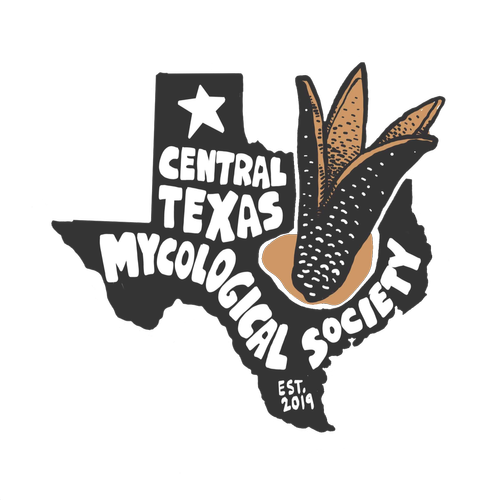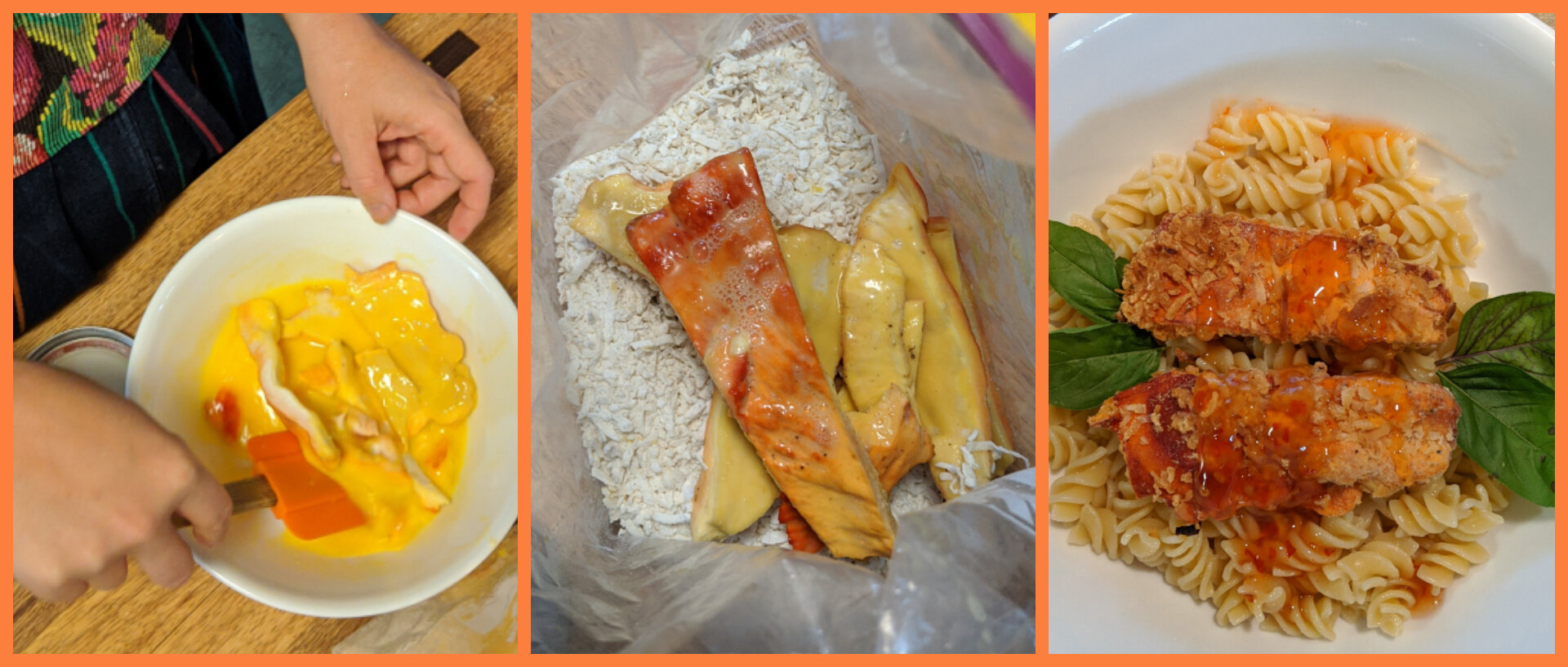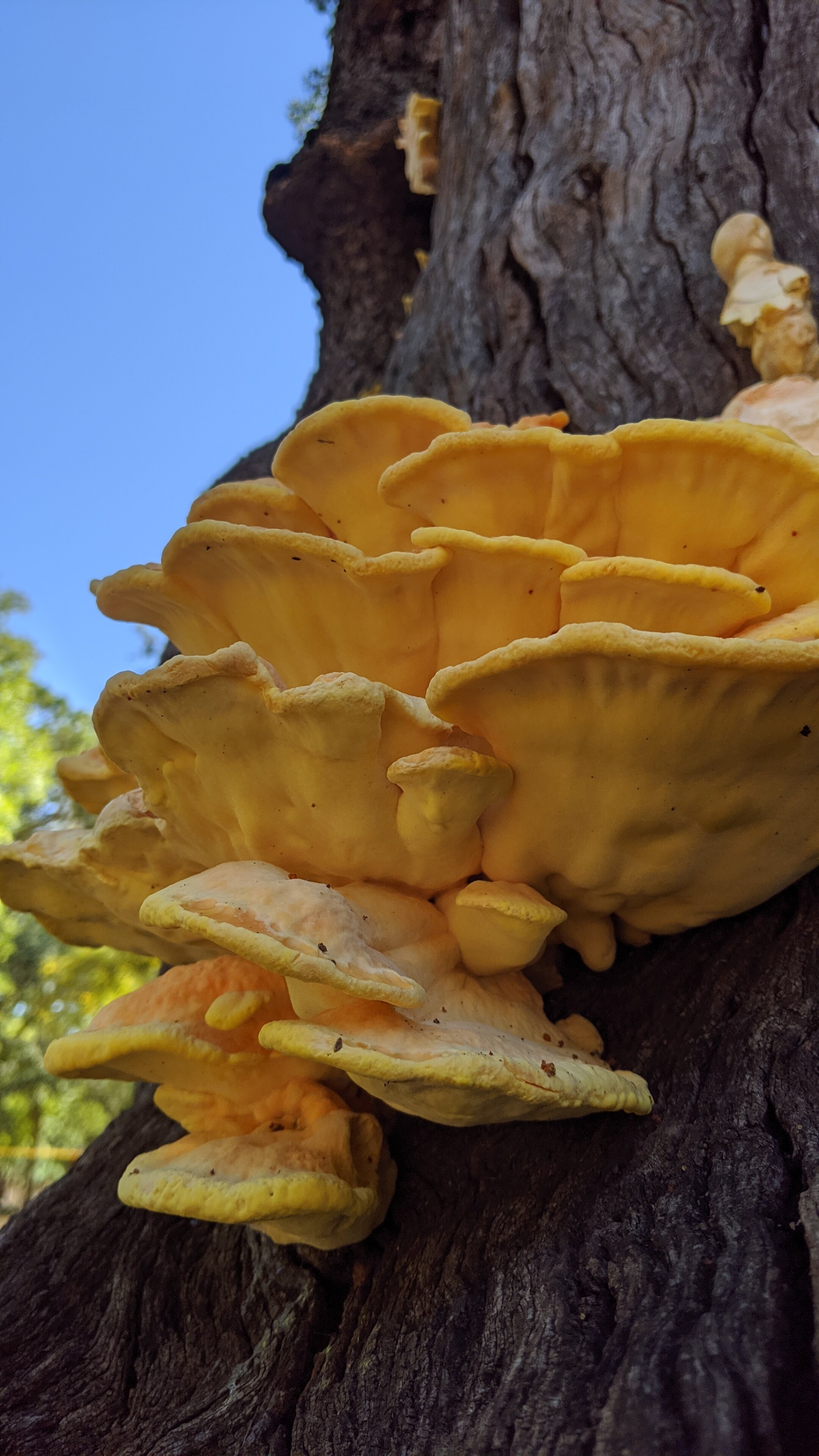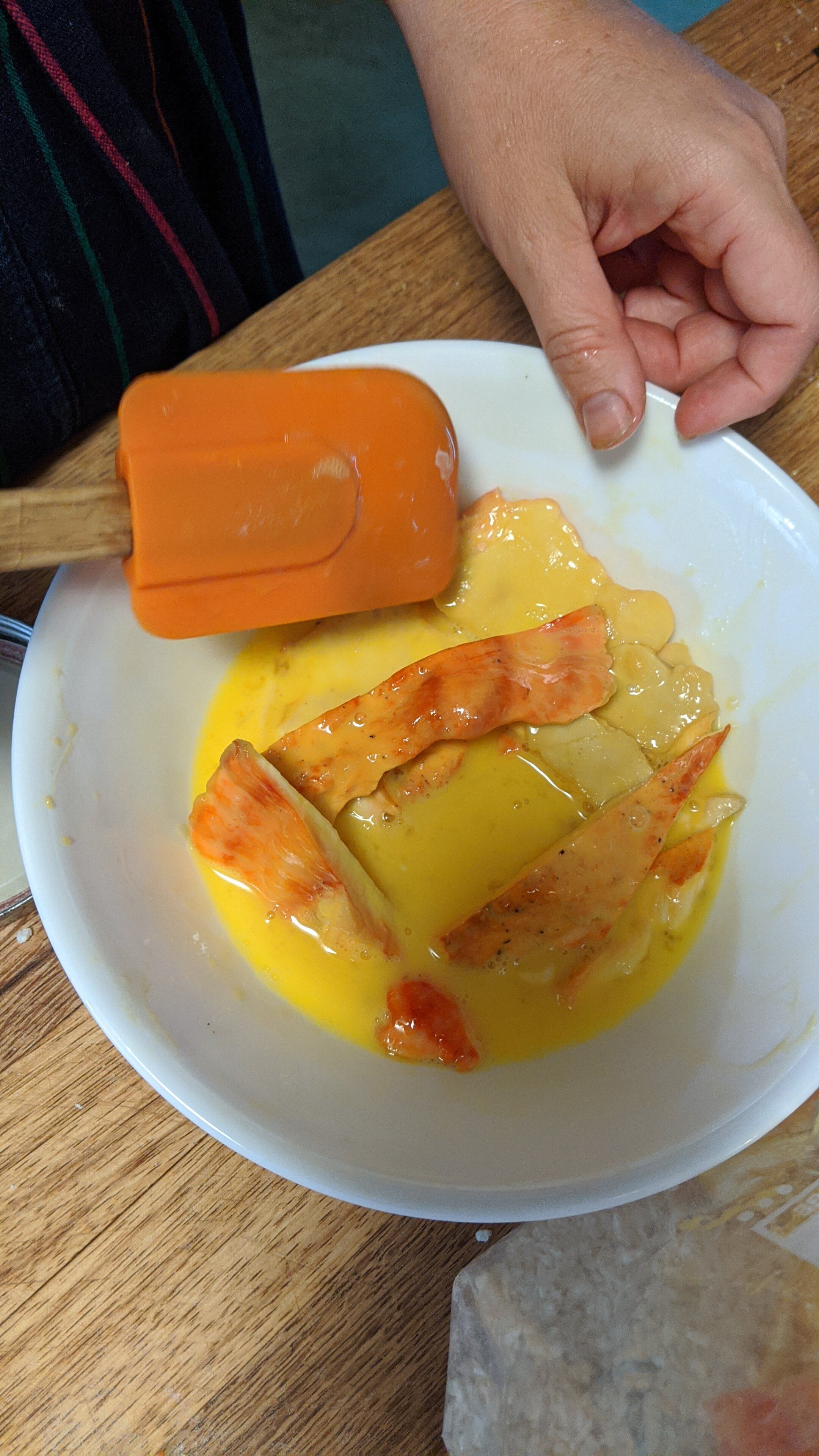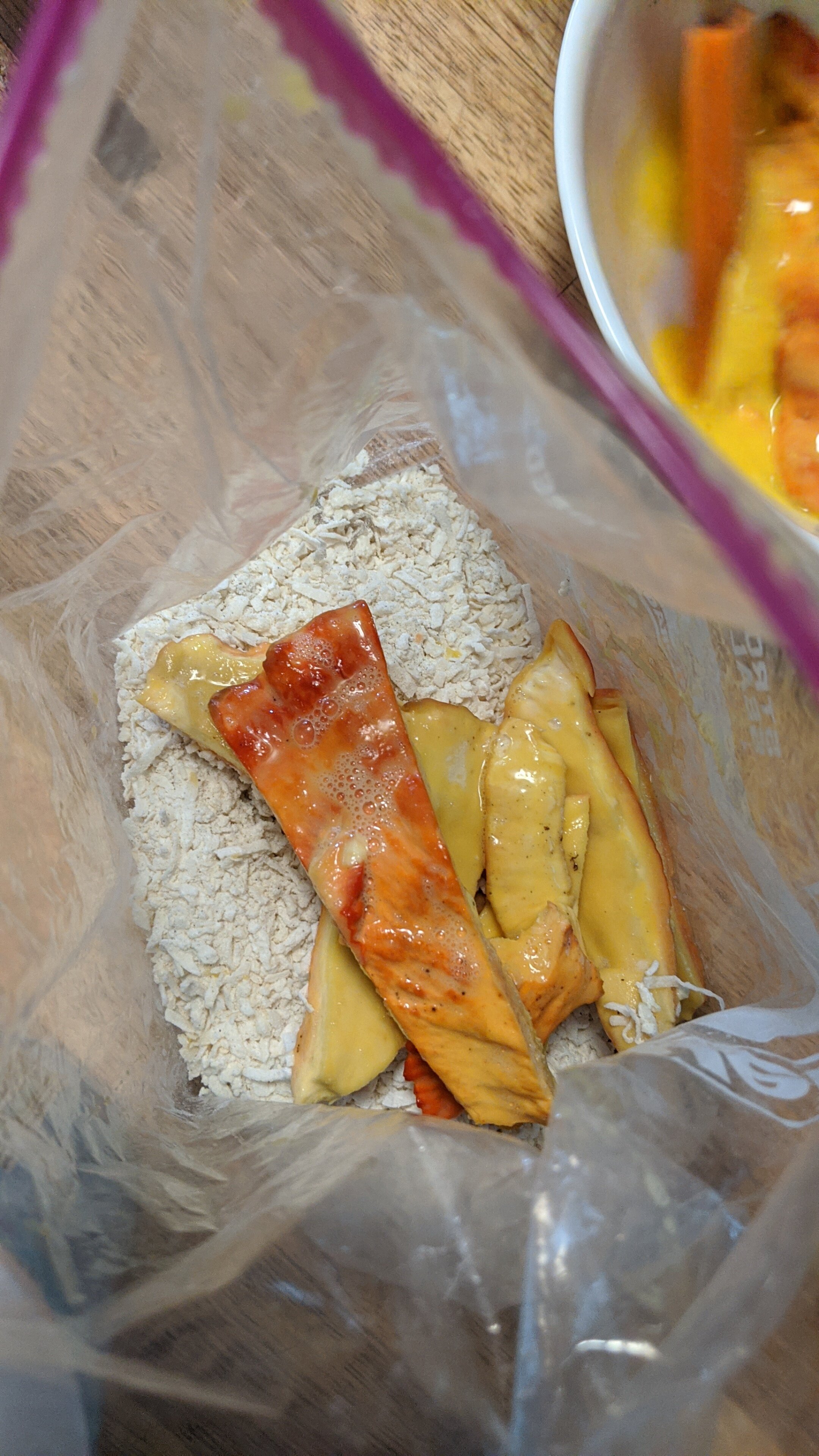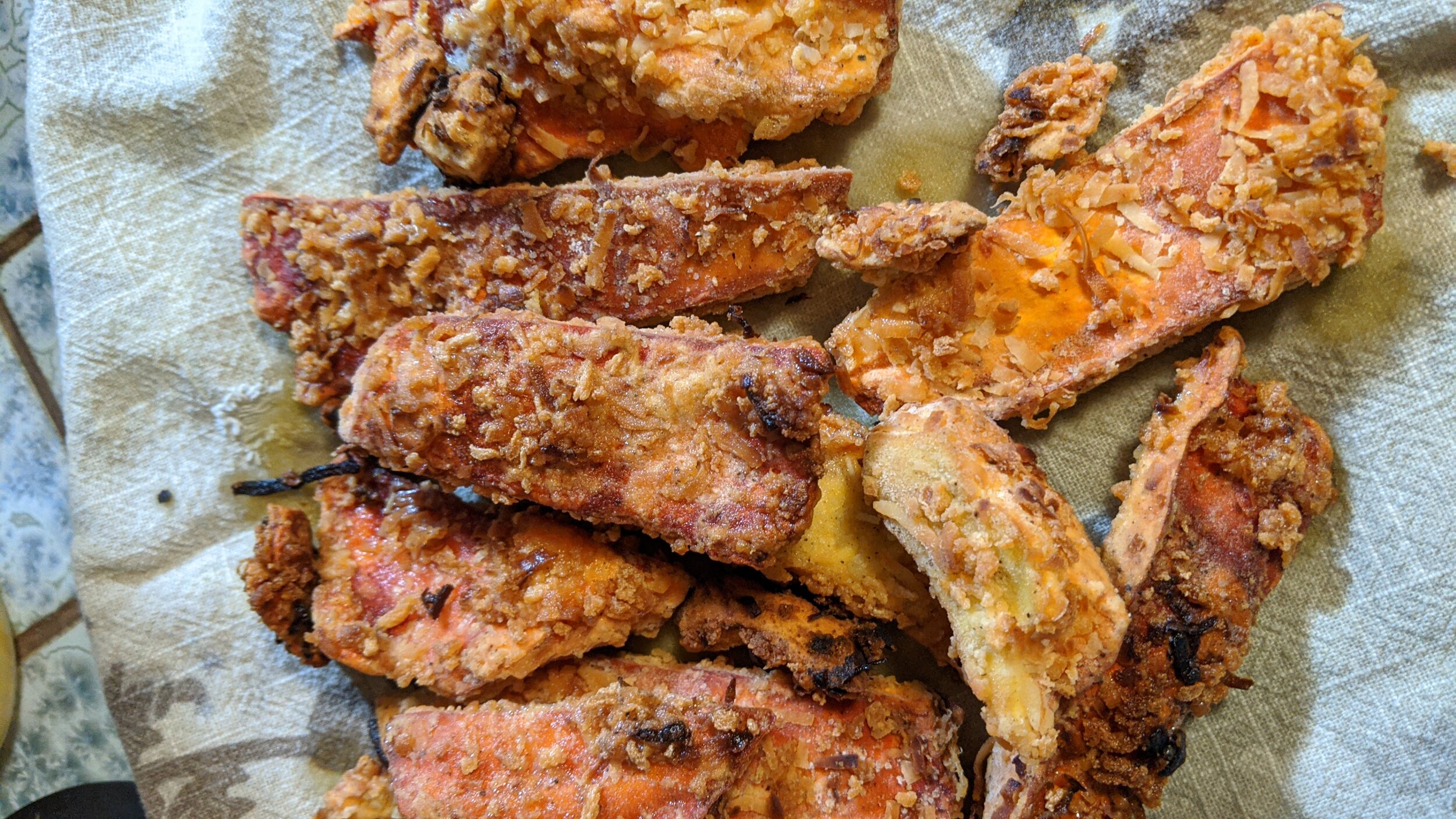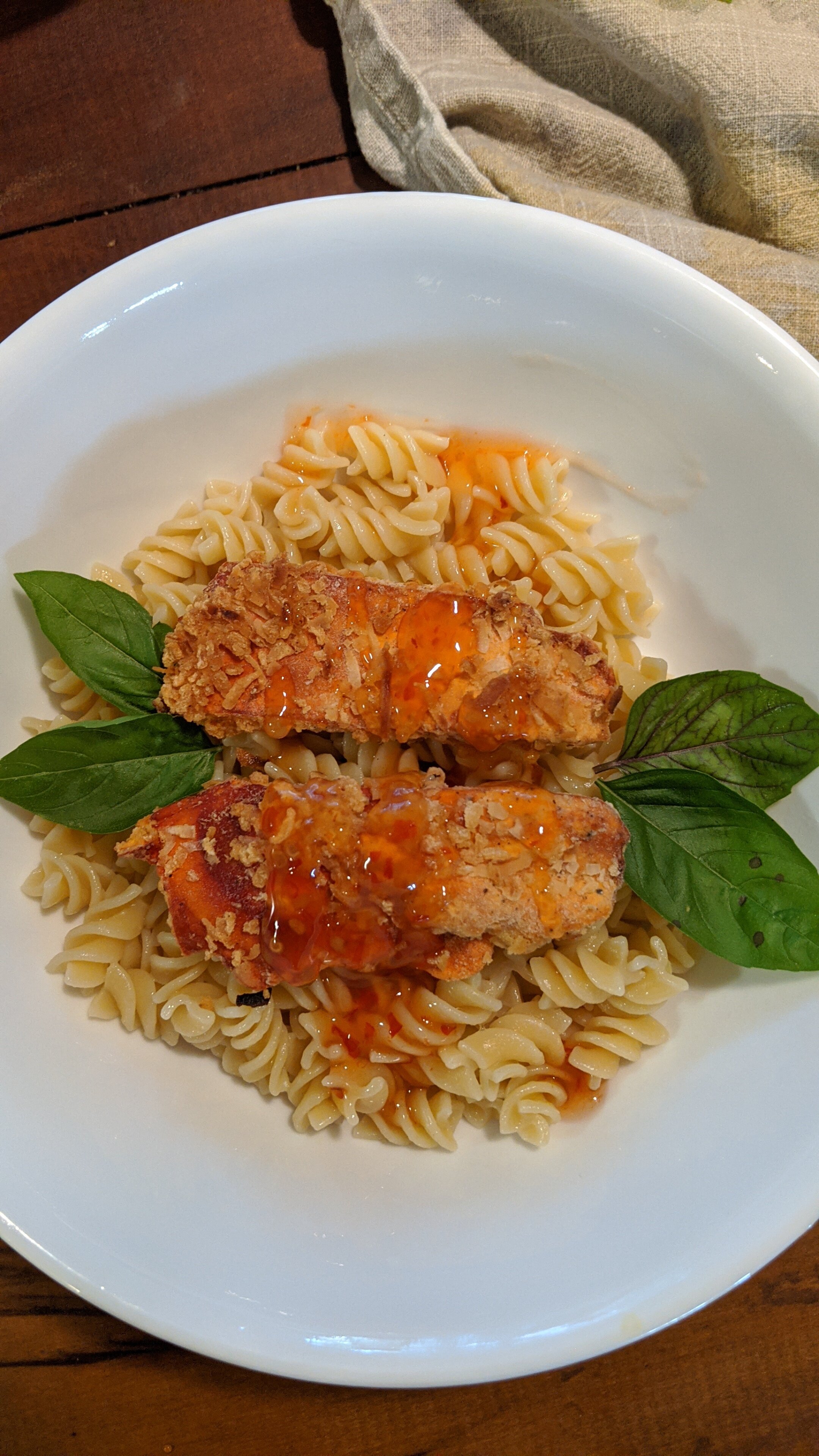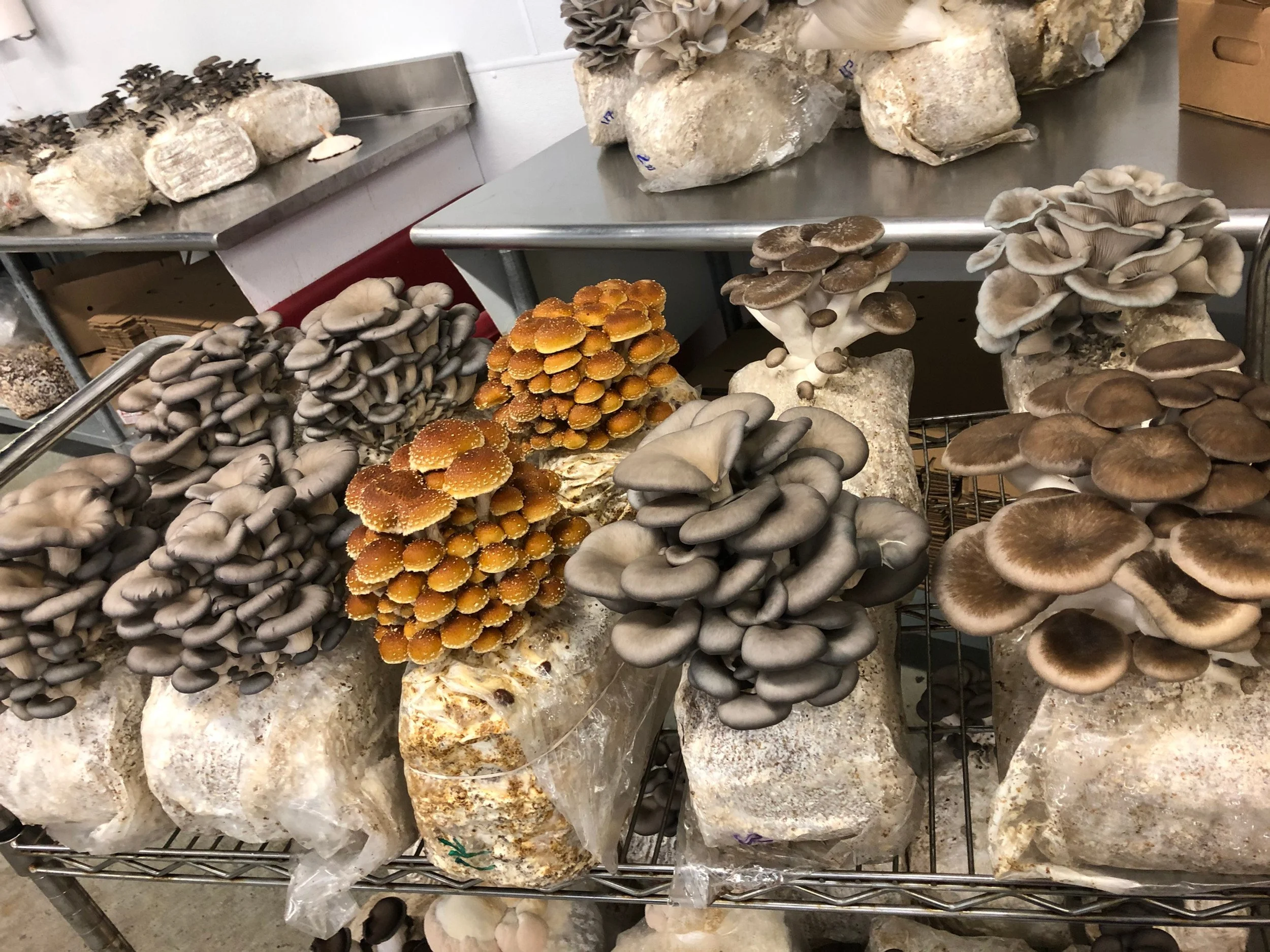From Deep Waters to Dry Land: Aquatic Facts About Fungi
Fungi started evolving in water over 500 million years ago from single-celled organisms.
Origins of Fungi
A billion-year-old fungi microfossil. (Credit: Loron et al. 2019 Nature)
Fungi started evolving in water over 500 million years ago from single-celled organisms. They eventually moved to land, adapting into forms like mushrooms, molds, and yeasts. Fungi helped plants colonize land, forming essential partnerships, and are vital to life on Earth today.
Fungi and Water in Ecosystems
Water Cycling: Fungi play a crucial role in water cycling in ecosystems by breaking down organic matter and releasing nutrients, which helps retain water in soils and enhances plant growth.
Mycorrhizal Networks: Mycorrhizal fungi form symbiotic relationships with plant roots, increasing the plant’s ability to absorb water and nutrients. This helps plants thrive in water-scarce environments and improves soil structure, which aids water retention.
Water Filtration: Some fungi can filter and clean water in ecosystems. Through mycofiltration, fungal mycelium can trap contaminants like heavy metals, bacteria, and pollutants in water, improving water quality.
Fungi in Aquatic Ecosystems: Fungi contribute to nutrient cycling in freshwater environments by breaking down plant and animal matter, helping maintain water quality and ecosystem balance in lakes, rivers, and wetlands.
Water-Saving Benefits of Growing Mushrooms:
Low Water Use: Compared to other crops, mushrooms require significantly less water to grow. For example, growing mushrooms uses only about 1.8 gallons of water per pound, whereas crops like lettuce need 28 gallons and avocados need 74 gallons per pound.
Efficient Water Usage: Mushrooms grow on composted agricultural waste, such as straw or sawdust, and need very little water beyond what is already in the substrate. This makes mushroom farming highly water-efficient.
Water Conservation in Farming: Because mushrooms grow indoors in controlled environments, water usage can be tightly managed, minimizing waste compared to traditional open-field farming methods that can lose water to evaporation and runoff.
Less Water Demand per Acre: A mushroom farm produces significantly more food per square foot than most conventional crops, and because mushrooms grow vertically in stacked trays, water demand per acre is much lower.
By reducing water consumption and improving soil and water health, fungi play a key role in sustainable agriculture and water conservation efforts.
Tag us on social media with your growing experiments.
How to Make a Shotgun Fruiting Chamber
A Shotgun Fruiting Chamber (SGFC) is a simple, low-cost setup used for growing mushrooms. It provides the right humidity and air exchange for mushroom fruiting. Here’s how to build one:
Materials:
Large clear plastic storage tote (about 50-60 liters)
Perlite (used for moisture)
Drill with 1/4-inch drill bit
Spray bottle (for misting)
Mushroom cakes or trays (e.g., PF Tek cakes)
Rack or shelf for inside the chamber (optional)
Steps:
Prepare the Container:
Choose a large, transparent plastic tote with a lid. The chamber needs to let in light for mushrooms to grow.
Drill 1/4-inch holes on all six sides (including the bottom and lid). Space the holes about 2 inches apart, creating a grid pattern. These holes allow for air exchange.
Prepare the Perlite:
Soak perlite in water. Drain it so that it's wet but not soaking. Perlite will provide the necessary humidity for your mushrooms to grow.
Spread about 4-5 inches of wet perlite evenly on the bottom of the tote.
Place a Rack or Shelf (optional):
If you want better airflow around your mushroom cakes or trays, place a small wire rack or shelf inside the chamber, above the perlite layer.
Place Mushroom Cakes:
Place your fully colonized mushroom cakes (from the PF Tek method or other substrates) on the perlite or on the rack, leaving space between them for airflow.
Maintain Humidity:
Mist the inside of the chamber (not directly on the cakes) with a spray bottle 2-4 times daily to maintain high humidity levels (85%-95%). Be careful not to overwater the perlite.
Fan for Air Exchange:
Fan the chamber by removing the lid and gently waving a piece of cardboard or the lid itself to encourage fresh air exchange. Do this 2-3 times daily to provide oxygen and encourage fruiting.
Provide Indirect Light:
Place the SGFC in an area with indirect light or use a small daylight spectrum lamp. Mushrooms need light to grow, but not direct sunlight.
Monitor and Harvest:
Keep an eye on the humidity, misting and fanning as needed. Within a week or so, mushrooms should start to form, and you'll be able to harvest them once mature.
Recipe: Coconut Chicken of the Woods
Coconut Chicken-of-the-Woods is a delicious way to prepare this choice edible mushroom.
Chicken of the Woods or Laetiporus species is choice edible and is highly nutritious fungi making it a great addition to a meat free diet. 100g of the mushroom contains 14g of protein, 6g of carbs, 3g of fiber and 150mg of potassium. In addition, it is rich in antioxidants, including flavonoids and phenols. These antioxidants have many medicinal benefits, such as anti-inflammatory, anti-viral, and anti-cancer properties. Since it doesn’t have any toxic look-a-likes, it is also a safe and mushroom to forage for beginners.
Coconut Chicken-of-the-Woods is my favorite way to prepare it.
Ingredients
1/3 cup all-purpose flour or whole wheat flour (spoon & leveled)
1/2 teaspoon salt
1/2 teaspoon ground black pepper
1/2 teaspoon red pepper
2 large eggs, beaten
3/4 cup Panko bread crumbs
1 cup sweetened shredded coconut
1 pound Chicken-of-the-Woods
Coconut Oil (Enough to fill frying pan 1 inch)
Instructions
Hand pull mushroom into strips or nuggets.
Dry sauté the pieces with 1/4 cup of water, salt and vinegar in a fry pan until water is absorbed or for 15 minutes. Drain excess water and use for broth, etc.
Combine flour, salt, and spices in one bowl. In a second bowl beat the eggs. Combine panko and coconut in the third bowl or large plastic freezer bag.
Dip the COW into the first bowl of flour and spices, then dredge in eggs, and then put the COW into the coconut and panko breading that is in a freezer bag and shake up.
Set the coated COW aside on a plate as you coat the remainder.
Add enough oil to cover the bottom of a large skillet on medium heat. Fry the coconut COW in batches – do not crowd them in the pan. I fried about 6-7 at a time. Flip after 2 minutes and fry the other side for 2 minutes or until golden brown. I like mine a little darker, so I fried each side for about 3 minutes.
Place the finished coconut COW on a plate lined with a towel as you fry the rest. Serve with your favorite sweet Thai chili sauce or an orange chili sauce.
Serve on top of your favorite pasta (optional) and sprinkle with a little chopped cilantro or basil (optional) and serve.
About Chicken-of-the-Woods
Scientific Name: Laetiporus sulphureus
Common Name: Chicken-of-the-Woods, Sulphur Shelf
Family: Polyporaceae
Description: Orange to yellow polypore, with yellow or white pores on underside.
Habitat: Grows in shelfs on heartwood of dead or dying oaks.
Spore Color: White Size: 6-12" width
Edibility: Contains proteins, fat, fiber and tastes just like chicken! Harvest when young, colorful, and moist. Becomes lighter in color, fiborus, mealy and dry, inedible with age.
Look-alikes: Shaggy Bracket, Inonotus hispidus (non-toxic)
Learn more about foraging it here.
October Mushroom of the Month: Laetiporus sp
The Mushroom of the Month for October is Laetiporus, aka Chicken of the Woods





🐔🍄🌳The October mushroom of the month is 𝘓𝘢𝘦𝘵𝘪𝘱𝘰𝘳𝘶𝘴 commonly known as Chicken of the Woods! This choice edible mushroom that can be found perching in oak trees in the fall.
🙌 to Barb Danko for naming that mushroom correctly and becoming the 1,312th member of Central Texas Mycology!
You can also be a supporting member to stay dialed-in with events & discover next month’s mystery mushroom.
FOWL OR FUNGI?
Chicken of the Woods contains several delightfully edible species. In central Texas, the two most commonly encountered are Laetiporus sulphureus (yellow spores) and Laetiporus gilbertsonii var. pallidus (white pores).This fantastic fungi gets its name from its flavor which, as you probably have guessed by now, tastes just like chicken! In Texas, Laetiporus grows on the heartwoods of Live Oaks and Red Oaks and occasionally on downed logs. Because these mushrooms are choice edibles with no poisonous look-alikes, they are a favorite for foragers.
FRIEND OR FOE?
Despite their popularity amongst fungal enthusiasts, Laetiporus is considered to be a nuisance by some arborists. This is mostly due to its status as a parasitic species that promotes brown rot in its host. However, evidence has shown that Laetiporus does not live up to its bad rap. In fact, Laetiporus is actually a cubical brown rot fungi (slow decomposer) and provides habitat for bees and other creatures as it slowly decomposes trees. It has been found growing on thriving 500+ year old live oak trees, proving that the relationship between fungi and host may be more symbiotic than parasitic.
edible + Medicinal
Chicken of the Woods is a highly nutritious fungi making it a great addition to a meat free diet. 100g of the mushroom contains 14g of protein, 6g of carbs, 3g of fiber and 150mg of potassium. In addition, it is
rich in antioxidants, including flavonoids and phenols. These antioxidants have many medicinal benefits, such as anti-inflammatory, anti-viral, and anti-cancer properties. Since it doesn’t have any toxic look-a-likes, it is also a safe and mushroom to forage for beginners.
BECOME A SUPPORTING MEMBER & stay Dialed in with events & discover next month’s mystery mushroom
Benefits of Green Mold, AKA Trichoderma Fungi
Trichoderma or Green Mold is a soil dwelling fungi found all over the world that causes problems in sterile mushroom farms. If a mushroom block has green mold growing on it, it’s not a loss. It actually benefits plants in the following ways:

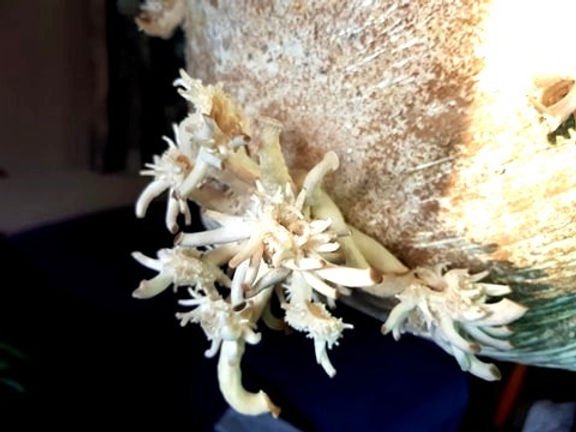
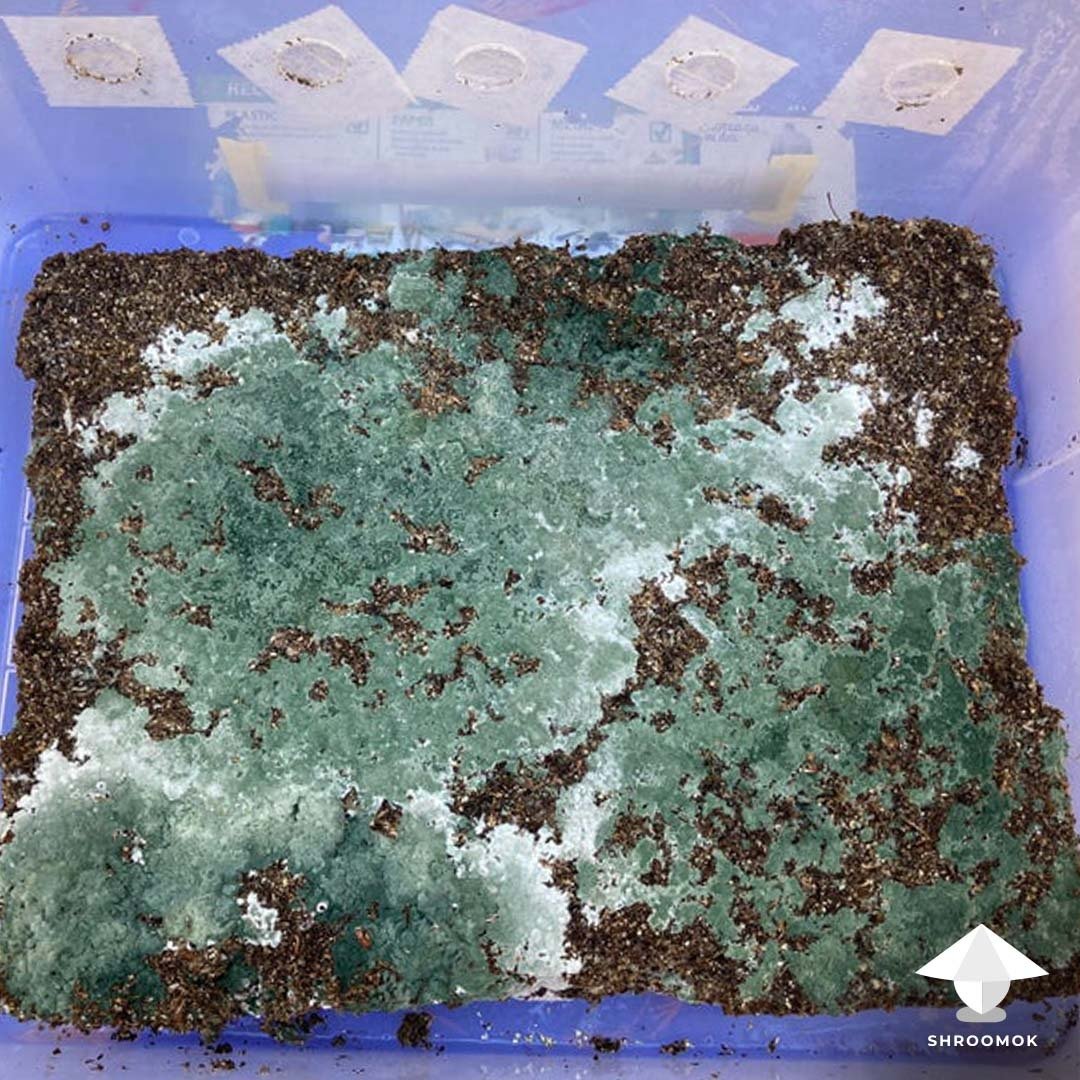


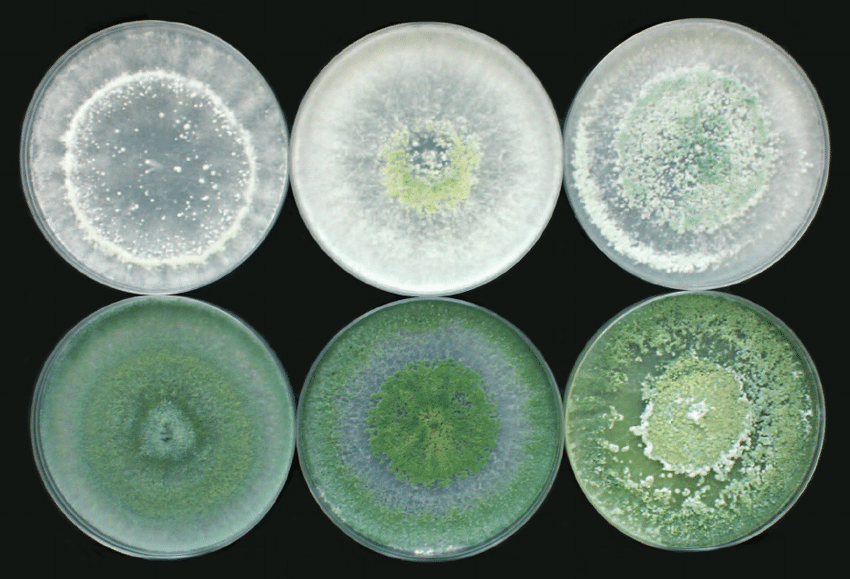
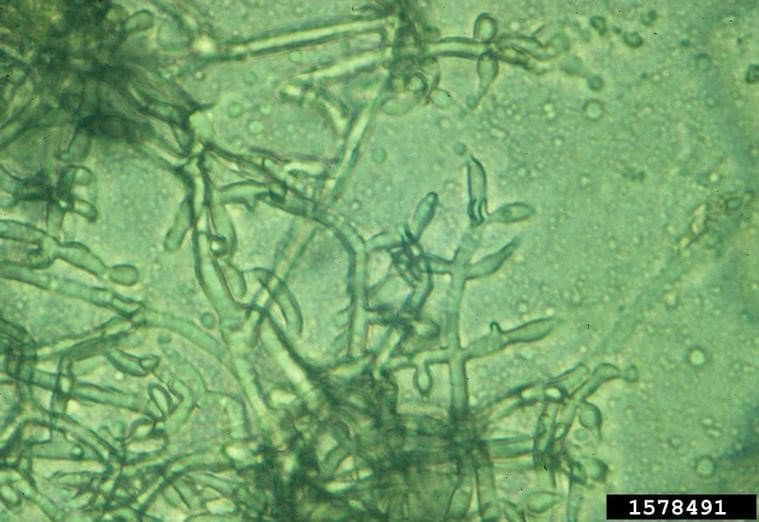
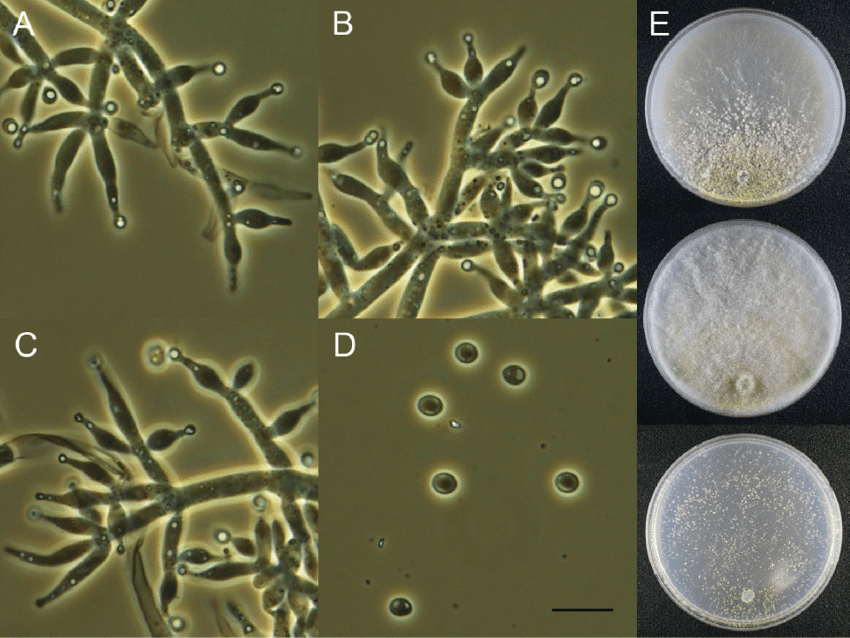
Trichoderma or Green Mold is a soil dwelling fungi found all over the world that causes problems in sterile mushroom farms. If a mushroom block has green mold growing on it, it’s not a loss. It actually benefits plants in the following ways:
Root Development: Trichoderma produces growth-promoting hormones like indole acetic acid (IAA), which stimulate root growth, leading to a more extensive and healthy root system. This allows trees to access more water and nutrients.
Enhanced Nutrient Uptake: Trichoderma forms a symbiotic relationship with tree roots, enhancing the absorption of nutrients, especially nitrogen, phosphorus, and essential micronutrients. This promotes better tree growth and vigor.
Disease Suppression: Trichoderma helps trees fight off pathogens by parasitizing harmful fungi and secreting enzymes that break down pathogen cell walls. This protects the tree from diseases, allowing it to grow without stress.
Stress Resistance: It boosts the tree's ability to withstand abiotic stresses like drought and salinity by producing compounds that enhance the plant’s stress tolerance mechanisms.
Soil Health: Trichoderma improves soil structure and fertility by breaking down organic matter and promoting microbial diversity, creating a better growing environment for trees.
Source: https://doi.org/10.1016/B978-0-12-822919-4.00003-X
Wear a mask when composting blocks with green mold. Breathing a lot of spores can cause respiratory issues.
How to ♼ Mushroom Blocks: FAQ's & Growing Tips
Learn how to recycle mushroom blocks.
FREQUENTLY ASKED QUESTIONS
What Are Mushroom Blocks?
Commercial farmers grow culinary mushrooms in plastic grow bags filled with a sterilized, organic blend of sawdust, grains, and nutrients that feed the mycelium (white stuff). NO SALTS USED The bags are kept on shelves in a controlled environment that simulates the temperture (65-75°F) and humidity (80-90%) that is ideal for the mushrooms. Once the block is fully colonized and covered with mycelium, it is ready to fruit. The bags are cut open to allow in enough oxygen for the mushroom to fruit. After 3-7 days, the mushrooms are ready to harvest. The blocks are donated to be composted or to grow more mushrooms. This is why the bags are already open.
WHERE DO THEY COME FROM?
From commercial mushroom farms in central Texas. Many times mushroom farms grow mushrooms once, and then end up getting tossed in the waste. In Austin, we are collaborating with a local mushroom farms to help keep used mushroom blocks out of the waste to give people the opportunity to grow them using various methods.
If you don’t live in Austin contact your local mushroom farm to see if you can take mushroom blocks to compost. Visit our map of Texas Mushroom Companies.
How DO I Grow ANOTHER FRUITING oF MUSHROOMS?
Keep mushroom block in the existing plastic bag and place out of direct light in a cool environment at 65-75°. A Martha Tent or Shotgun Fruiting Chamber is a great idea to contain the spores and helps create a humid environment when temperatures are too hot outdoors.
Spritz with water 2-3x per day
After about 2-3 weeks, the mycelium (white stuff) will start to develop “pins” or baby mushrooms.
Water more frequently and in 2-5 days a “flush” of mushrooms will be ready. Harvest with a knife before the caps curl up!
Compost after harvest.
WILL MUSHROOM BLOCKS GROW ANOTHER MUSHROOM THAT IS POISONOUS?
No, a mushroom grow block will not randomly grow a poisonous mushroom. The block is inoculated with a specific fungal species, and unless contaminated by another fungus, it will only produce the intended mushroom. However, if once opened and exposed to wild spores, other fungi like green mold or trichoderma will colonize it. This fungus is really beneficial to plants and actual prevent other fungal pathogens. Learn more about benefits. Always have an expert identify any unexpected growth before consuming!
DOES THE MUSHROOM BLOCKS CONTAIN SALTS THAT WILL HURT MY PLANTS?
NO! Many studies on mushroom compost like this one advise against using a lot of mushroom compost because they contain high salts. NO SALTS are used in the process of growing gourmet, culinary mushrooms like oysters and lions mane. These are WOOD-LOVING mushrooms and they grow on sawdust, grains and nutrients.
Mushroom farm such as Kitchen Pride (which we don’t work with) produce white button mushrooms such as cremini and portobello. These are DUNG-LOVING or mushrooms that grow on manure and have soluble salts used in the process. This type of compost contains high levels soluble salts that can harm young seedlings and kill germinating seeds. Since these are a very common mushroom grown and there are a lot of research and content about spent mushroom compost it appears at the top of search results.
What Kind of Mushrooms Are THey?
Look for a tag with a code on the bag and also look at the hole in the bag to determine variety. The top three are the most common.
🌀 B- Blue Oysters
Flavor: Sweet and meaty with hints of licorice. Perfect for braising, sautéing, roasting, frying, grilling, and stir-frying.
💛 G - YO: Golden or Yellow Oysters
Flavor: Mild, nutty flavor. Cooked until golden and slightly crispy with a little butter and garlic. Try making an oyster mushroom “steak” recipe.
🦁 L - Lions Mane
Flavor: Tender texture that mimics shellfish like scallops, crab, or lobster. A great alternative to seafood. Read about medicinal values.
C-Chestnut
Earthy aroma and mildly sweet flavor with distinct hints of nuttiness. Commonly compare their flavor to shiitakes.
P - Pink Oyster
Taste like bacon or ham, and the flavor intensifies when cooked. The aroma is pungent and meaty wonderful meat substitute in many dishes.
O-Pioppini
Earthy, nutty flavor with subtly sweet, floral, and peppery note. Popular in pasta dishes and risotto.
E-Enoki
Mild, delicate, and slightly sweet. They have a subtle crunch and a chewy texture that makes them a great addition to salads, soups, and stir-fries. Often described as nutty, with a hint of earthiness that adds depth to dishes.
A-Local Oyster
Some people report a seafood-like taste while others just say woodsy — it probably varies a bit depending on the environment it is growing
D-Black Pearl
Meaty yet airy flavor with hints of sweetness. When cooked, it packs a savory punch and is a reliable ingredient for adding umami flavor to a dish.
GROWING TIPS
KEY ELEMENTS NEEDED FOR GROWING
HUMIDITY
Ideal humidity is 80-90% so spray with filtered water 2-3 times a day and keep in a humid area. Try putting them inside a cardboard box or container to contain humidity. Just remember air flow and light are also important.
Air Circulation
Mushrooms give off carbon dioxide and intake oxygen so give them a space for air circulation.
If you see green, moldy spots, then feed the block to your compost. Green mold is great for plant growth.
LIGHT
During the colonizing stage (3+ weeks), keep your mushrooms in a cool, dark place below 80°. Once you see “pins” aka baby mushrooms, give your mushroom more light and oxygen. UV light is how mushrooms create vitamin D.
GROW INDOORS: (Anytime)
Leave in the bag and put in moist area like a kitchen or in bathroom, place into a plastic tote, cardboard box, greenhouse or humidity tent.
Air circulation is important. Turn on overhead fan or place fan facing away from mushrooms.
Keep Moist: Spritz with water on slit daily. Keep an eye out for pins (tiny mushies), water 2 - 3x a day.
Harvest after 3 - 5 days before the caps start to curl up and spores drop.
Compost or use as mulch in garden.
GROW OUTDOORS: (Fall-Spring)
Leave the block in the existing bag and place it in a shady spot under a tree or shrub, on your porch.
Keep it moist, water daily. They love rain water so make sure they can get exposed.
Keep an eye out for pins (tiny mushies), water 2-3x a day.
Harvest after 3 - 5 days before the caps start to curl up.
Compost or use as mulch in garden.
Left: caps still folded down, not dropping spores. Perfect to harvest
Right: edges flattened upwards. Dropping spores now, great to eat but take it outside
ADDITIONAL TIPS
Fold the bag over the slit to retain moisture until you see tiny mushrooms. If possible, keep the square white filter patch directly accessible for airflow.
Spritz water around the mushrooms (not directly) for best results.
Mushroom blocks make liquid over time! Just pour it out!
After a few times fruiting, the block will be done. Unbag, smash, and compost!
How to Use as Compost
Smash up entire contents of bag and sprinkle in garden beds, around the base of trees with mulch, or mix in your compost pile. Dispose of plastic bag in the trash.
Benefits of Recycling Mushroom Blocks
Great for soil health
Supports the ecosystem
Keeps methane out of landfills (good for climate!)
Fill your belly with delicious and nutritious organic mushrooms for free
Support your local mush community!
learn more ways to COMPOST & grow mushrooms OUTDOORS in the garden and sign-up to get recycled mushroom blocks.
IMPORTANT ALLERGY PRECAUTION
Spores can cause problems indoors for people with allergies. Keeping them in sight is important. If you are going out of town for an extended period put them outside because mushrooms can grow and spread spores in 5-7 days. If you see any mold forming on your block, use a spoon to break it off and dispose of it immediately outdoors. Mold spores, like mushroom spores, are not good to inhale in large quantities.
HOW TO SUPPORT THIS INITIATIVE
Help us continue this waste diversion initiative by leaving us a donation. (Suggestion is $5 per block). We are using the money to build a mobile lab and community mushroom spawn library to continue mycology education throughout Texas.
Central Texas Mycological Society is always looking for more members to support our mission of educating the community about the benefits of fungi.
Tag us ONLINE with pics of your MUSHROOM GROWING experiments OR SHARE YOUR STORY HERE.
October Foraging Forecast
Learn wild, edible mushrooms fruiting in Texas after rain.
Learn wild, edible mushrooms fruiting in Texas after rain.
Comes with download of a Wild Edible Mushroom Calendar.
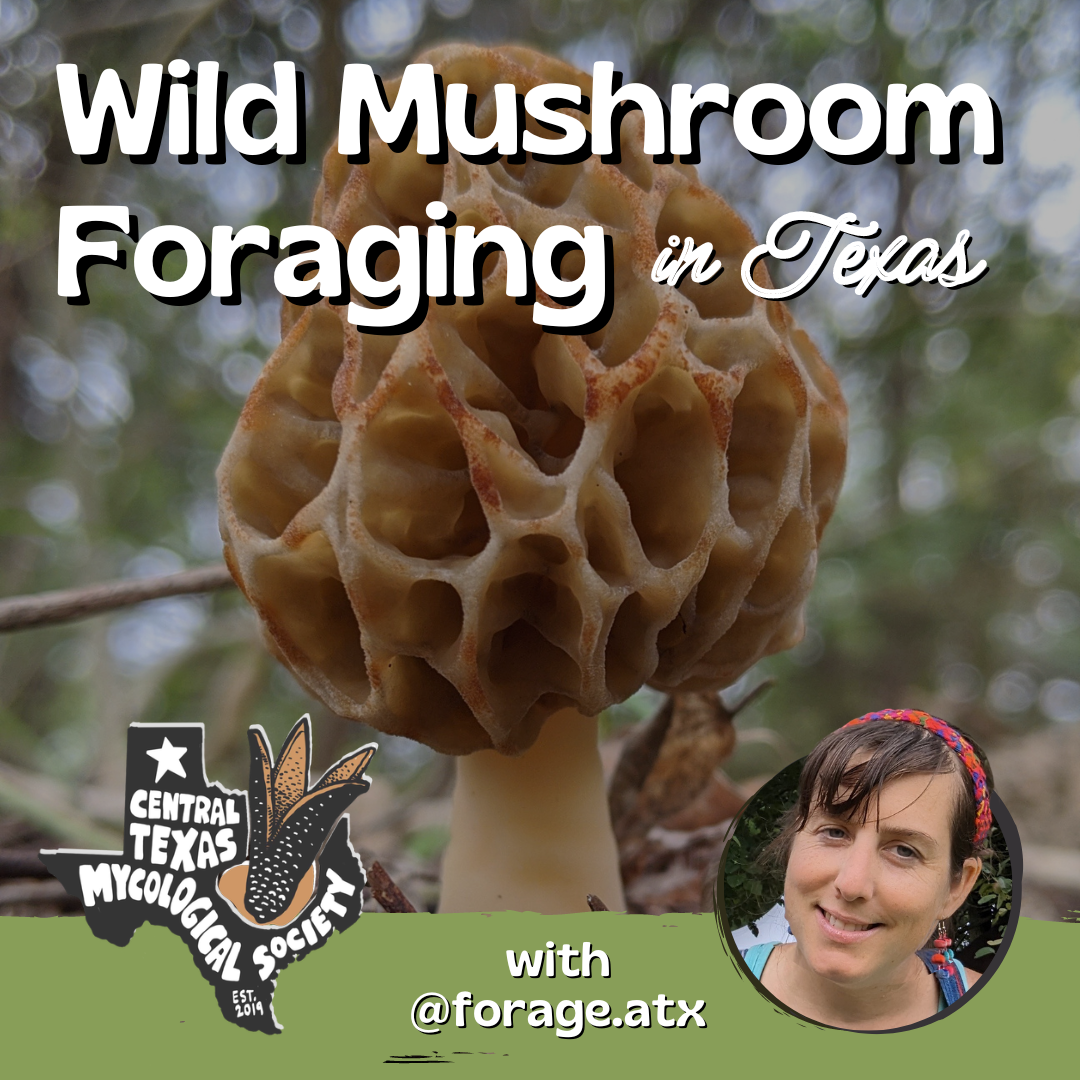
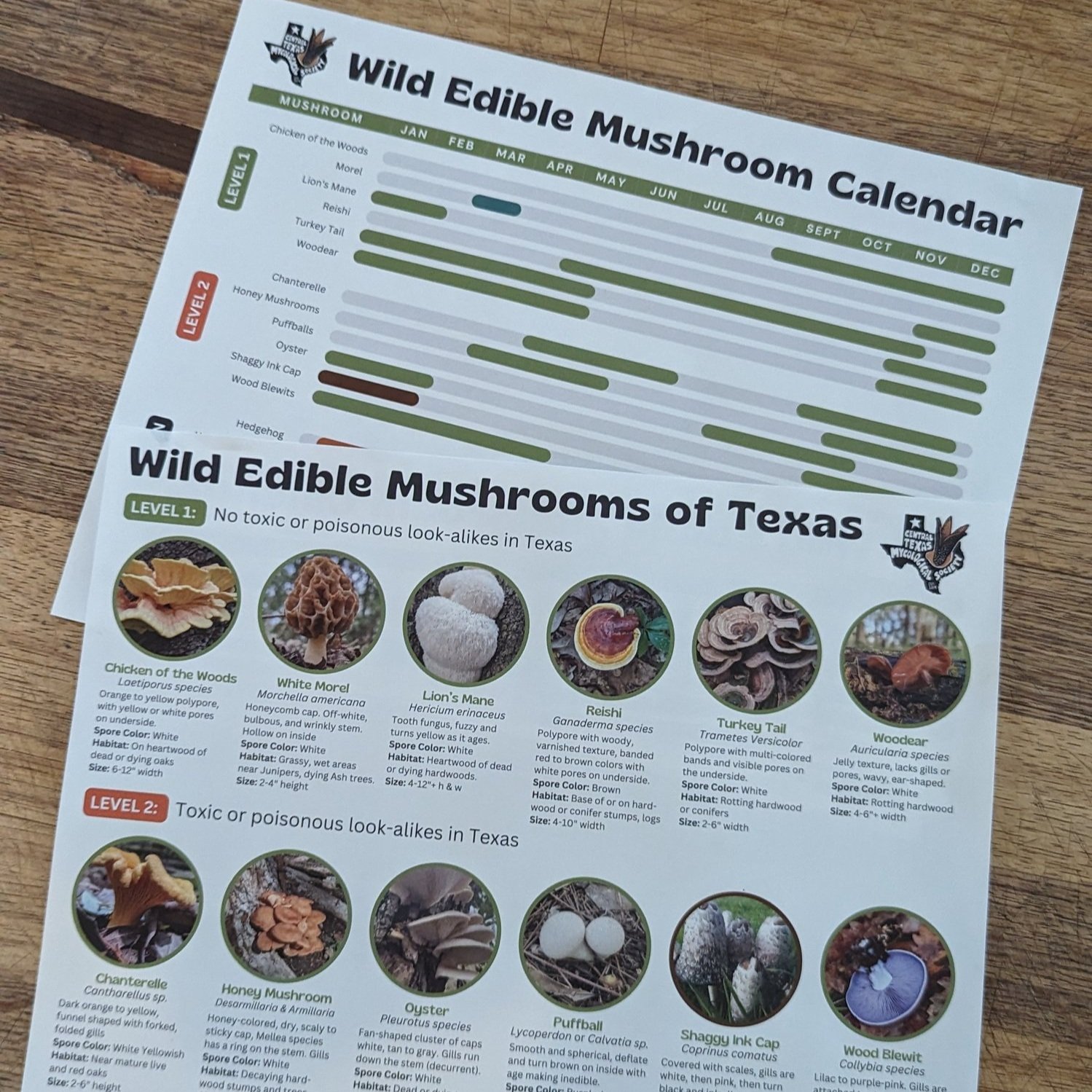
Chicken of the Woods: Laetiporus, 4 species in texas
DESCRIPTION: Orange to yellow polypore, with yellow or white pores on underside.
Habitat: Grows in shelfs on heartwood of dead or dying oaks.
Spore Color: White Size: 6-12" width
Edibility: Contains proteins, fat, fiber and tastes just like chicken! Harvest when young, colorful, and moist. Becomes lighter in color, fiborus, mealy and dry, inedible with age.
Look-alikes: Shaggy Bracket, Inonotus hispidus (non-toxic)
Ringless Honey Mushroom: Desarmillaria & ArmillariA Species
Ringless Honey Mushroom, Desarmillaria caespitosa will start been popping up all over Austin in large clusters at the bases of trees (when the clusters appear to be terrestrial they are actually growing from underground wood) in late summer and fall. This parasitic fungus is part of a genus that is the largest living organism ever found on this planet.
Description: Honey-colored, dry, scaly to sticky cap. Mellea species has a ring on the stem. Gills, some species have a ring.
Habitat: Grows in clusters on decaying hard-wood.
Spore Color: White
Size: 6" in Height
Edibility: Not Choice.
Look-alikes: Southern Jack-o-lantern, Omphalotus subilludens which is toxic and orange to brown in color.
REISHI: Ganoderma, 12 species in Texas
DESCRIPTION: Polypore with woody, varnished texture, banded red to brown colors with white pores on underside.
HABITAT: Grows at base or on hardwood stumps, logs, especially oaks and pecan. Pines in East Texas.
SPORE COLOR: Brown
SIZE: 4-10" width
EDIBILITY: Medicinal. Very bitter because of medicinal compounds.
LOOK-ALIKES: Red-Belted Conk, Fomitosis Pinicola (also medicinal).
honeycomb fungus: FavoluS 3 species in Texas
DESCRIPTION: Genus of tropical fungi in the family Polyporaceae but with fleshy with radially arranged pores on the underside of the cap that are angular and deeply pitted, somewhat resembling a honeycomb. White to yellow and grows alone or in overlapping clusters similar to oyster mushrooms or other shelf fungi.
HABITAT: On decaying hard-wood, year round when humidity is high after rain.
SPORE COLOR: White
SIZE: 3-6" wide
EDIBILITY: Odor slightly foul, especially in rehydrated material; taste not distinctive. Tough texture and can be cooked like chicharrones.
LOOK A-LIKE: Oysters, Pluerotus or Lentinellus cochleatus (none observed in Texas) but grow on decomposing wood.
WOOD EAR: Auricularia 6+- species in Texas
DESCRIPTION: Brown to amber in color. Jelly texture that is irregular, wavy, and ear-shaped. Lacks gills or pores.
HABITAT: Grows in clusters on decaying hardwood after rain
SPORE COLOR: White
SIZE: 4-6" in width and > 1/4" thick
EDIBILITY: Wood ear mushrooms are a popular ingredient in many Chinese dishes, such as hot and sour soup, and also used in Chinese medicine. It is also used in Ghana, as a blood tonic. Modern research into possible medical applications has variously concluded that wood ear has anti-tumor, hypoglycemic, anticoagulant and cholesterol-lowering properties.
LOOK-ALIKES: Amber Jelly, Exidia recisa which is also edible.
Puffball: Lycoperdon and Calvatia, 15+- species in Texas
DESCRIPTION: Smooth and spherical, deflate and turn purplish or brown on inside with age making inedible. Some peal and have spines.
HABITAT: Overgrazed Prairie or grasslands.
SPORE COLOR: Purple-brown
SIZE: 2- 60" diameter
EDIBILITY: Doesn’t have a strong flavor of its own and absorb flavors. Try making a Giant Puffball Pizza.
LOOK-ALIKES: Amanita species which can contain toxins and be fatal. If center of puffball is not white, it can cause GI distress.
Blue Milkcap: Lactarius Indigo
DESCRIPTION: Blue cap with concentric rings and a depression in center, sticky or slimy to the touch. Brittle flesh, stem. Gills and body exude blue latex when injured tissue is and stains the wounded tissue greenish blue.
HABITAT: Mycorrhizal and grows in deciduous and coniferous forests.
SPORE COLOR: Cream
SIZE: 2.0–5.9" cap width
EDIBILITY: Choice. Peppery taste and has a coarse, grainy texture.
LOOK-ALIKES: Blewit, Collybia nuda or Lactarius paradoxus (edible)
CHANTERELLE: Cantharellus, 10+- species in Texas
DESCRIPTION: Red, orange, yellow to white, meaty and funnel-shaped and can be found in clusters or individual mushrooms. On the lower surface, underneath the smooth cap, most species have rounded, forked folds that run almost all the way down the stipe, which tapers down seamlessly from the cap.
HABITAT: Symbiotic and found around 5-30 feet of mature live and red oaks after a lot of rain. Chanterelles need a lot of rain to fruit and they like the torrential Texas-style flash floods. Trees near creeks and where water is flowing downhill is very important. Avoid trees that are in areas that are mowed. Trees with undisturbed leaf matter and not many understory plants are ideal.
SPORE COLOR: White Yellowish
SIZE: 2-6" height
EDIBILITY: Choice. Many species emit a fruity aroma, reminiscent of apricots, and often have a mildly peppery taste.
LOOK A-LIKE: The Southern Jack-o-lantern, Omphalotus subilludens is the toxic look-a-like and is orange to brown in color. They do grow at the same time but their habitat and morphology is different.
OYSTER: Pleurotus ostreatus
DESCRIPTION: Color can vary white, tan and gray.White to cream gills, run down stem.
HABITAT: Grows in clusters and decomposes hardwood.
SPORE COLOR: White
SIZE: Cap fan shaped, 2"-8" across.
EDIBILITY: Choice. Delicious meat replacement in all types of cuisines
LOOK A-LIKE: The Southern Jack-o-lantern, Omphalotus subilludens is the toxic look-a-like and is orange to brown in color. They do grow at the same time but their habitat and morphology is different.
TURKEY TAIL Trametes versicolor
DESCRIPTION: Variable coloration, distinct striping pattern. No gills, pores are small and round, white to light brown
HABITAT: Grows in overlapping clusters on logs and stumps
SPORE COLOR: White
SIZE: Cap fan shaped, 2"-8" across.
EDIBILITY: Medicinal. Tough, leathery flesh. Can be brewed into a tea, broth, or extracted into a tincture.
LOOK A-LIKE: False turkey tail. or Stereum ostrea and is non-toxic. Mushroom Expert has a useful check list to determine if it is true medicinal turkey tail.
Become a member and learn more about wild mushroom foraging in Texas!
Membership benefits include early access and discounts to walks, workshops, and more. Your membership helps support the larger community! Tag us to get help with ID and add your observations to iNaturalist.org. If you are trying a new mushroom, confirm the ID with an expert, then try a small amount to make sure you don't have an allergic reaction. Texas Mushroom Identification Facebook group is great for quick responses and ID help. Also, don't forget to add your finds on the Mushrooms of Texas project on iNaturalist.
Follow my adventures @forage.atx.
September Mushroom of the Month: 𝘗𝘪𝘴𝘰𝘭𝘪𝘵𝘩𝘶𝘴 𝘢𝘳𝘩𝘪𝘻𝘶𝘴
The Mushroom of the Month for September is the, 𝘗𝘪𝘴𝘰𝘭𝘪𝘵𝘩𝘶𝘴 𝘢𝘳𝘩𝘪𝘻𝘶𝘴





🌈🐶💩The September mushroom of the month is the 𝘗𝘪𝘴𝘰𝘭𝘪𝘵𝘩𝘶𝘴 𝘢𝘳𝘩𝘪𝘻𝘶𝘴, colloquial names - Dead Man’s Foot, Bohemian truffle and Dog Turd Fungus, used for dyeing fabric and is also a mycorrhizal inoculate and helps plants establish roots. Swipe to learn more about this fascinating mushroom.
🙌 to @chaoticmessy for naming that mushroom correctly and becoming the 1,301th member of Central Texas Mycology!
Become a supporting member to stay dialed-in with events & discover next month’s mystery mushroom.
What is that thing?
Many people find themselves asking this question when coming across Pisolithus in the wild, which has led to it being called by many interesting colloquial names - Dead Man’s Foot, Bohemian truffle and Dog Turd Fungus, to name a few. It is a prolific species that occurs worldwide, sometimes growing by itself and other times mycorrhizal with pine, oaks and cedars. The fruiting body is 5–30 cm tall and 4–20 cm wide, with a thin yellow-brown to brown exterior layer and the spores are brown.
natural colors with Pisolithus
The common name of Dyeball refers to the traditional use of this fungus as a natural dye for textiles. Pisolithus starts out as a club-shaped dark brown object, that when cut open shows those ‘peas’ — little compartments in which the spores are formed, resembling what has been described as ‘rice crispies in tar’. In this stage, the mushroom is firm, wet, and will stains whatever it touches. In the next phase the top matures, the outer wall disintegrates and a dark chocolate brown dry spore mass is visible. The spores have pigmented hydrophobic walls, making them effective for long distance travel and also a powerful coloring agent.
is it edible?
While the Dyeball is not an edible mushroom for humans, it is highly nutritious for plants, especially trees! Because it forms mycorrhizas with almost any kind of root, this ectomycorrhizal fungus is frequently used by foresters (and in recent years by gardeners, too) as the basis of a soil inoculant to promote tree and plant growth - particularly in remediation of areas of degraded or polluted land or formerly clear-felled forest sites.
BECOME A SUPPORTING MEMBER & stay Dialed in with events & discover next month’s mystery mushroom
August Mushroom of the Month: Flower Pot Parasol
The Mushroom of the Month for August is the Flower Pot Parasol, Leucocoprinus birnbaumii





🔥The August mushroom of the month is the Leucocoprinus birnbaumii, commonly known as the Flower Pot Parasol, a saprophytic fungi native to the tropics. In recent times it has become common in greenhouses and indoor plants in temperate regions, its spores having hitched rides in the tropical plant trade.
🙌 to Aerie for naming that mushroom correctly and becoming the newest member of Central Texas Mycology!
Why the name?
The Flower Pot Parasol, aka yellow parasol, flowerpot parasol, or plantpot dapperling, is a species of gilled mushroom in the family Agaricaceae. It is common in the tropics and subtropics but in temperate regions it frequently occurs in greenhouses and flowerpots, hence its common names.
how did it get into my flower pot?
The Flower Pot Parasol was first described in 1788 by English mycologist James Bolton who described an observation from a hothouse near Halifax, three years earlier in 1785. During this era, exotic plants from tropical areas were being brought to and cultivated in greenhouses and gardens from the East Indies and India, so it is likely the spores hitched a ride in the soil or mulch.
is it edible?
Although the Flower Pot Parasol does look beautiful it is not edible. Though it will not kill you, it will cause some very unpleasant gastrointestinal irritation. However, it may have medicinal uses. A 2015 study showed that fatty acids extracted from Leucocoprinus birnbaumii have moderate but selective anti-microbial effects.
BECOME A SUPPORTING MEMBER & stay Dialed in with events & discover next month’s mystery mushroom
July Mushroom of the Month: Southern Clam Shell, Fomes fasciatus
The July mushroom of the month is the 𝘍𝘰𝘮𝘦𝘴 𝘧𝘢𝘴𝘤𝘪𝘢𝘵𝘶𝘴





🔥The July mushroom of the month is the 𝘍𝘰𝘮𝘦𝘴 𝘧𝘢𝘴𝘤𝘪𝘢𝘵𝘶𝘴, commonly known as the Southern Clam Shell, a white rot fungi that grows in the Southeastern parts of North America and is a tinder conch and can be used to start fire.
🙌 to Eldon for naming that mushroom correctly and becoming the newest member of Central Texas Mycology!
WHAT IS IT?
The Southern Clam Shell, Fomes fasciatus, is a pathogenic white rot polypore fungus that grows on hardwood trees in southeastern North America, South and Central America. It has also been documented in Australia and Asia. It has a hard outer shell shaped like a clam or hoof, earning it the nickname ‘horse hoof’ fungus.
Traditional uses
The Southern Clam Shell has an interior trauma layer that can be harvested for tinder. The material, called Amadou, has been coveted since ancient times for its ability to start fires quickly even in inclement condi-tions. Otzi, the famous 5,300 year old mummy found frozen in the alps, was carrying Fomes fomentarius, the northern relative of the Southern Clam Shell, when he died.
FUTURE USES
Fomes fasciatus has also been researched as a potential cheap biosorbent of heavy metals due to its common occurrence and lack of current economic use. The research evaluated the dried and pulverized fruiting bodies ability to absorb Cu II (copper compounds) commonly found in wastewater and found that treating the prepared fungi with hot-alkali improved its sorbent properties.
